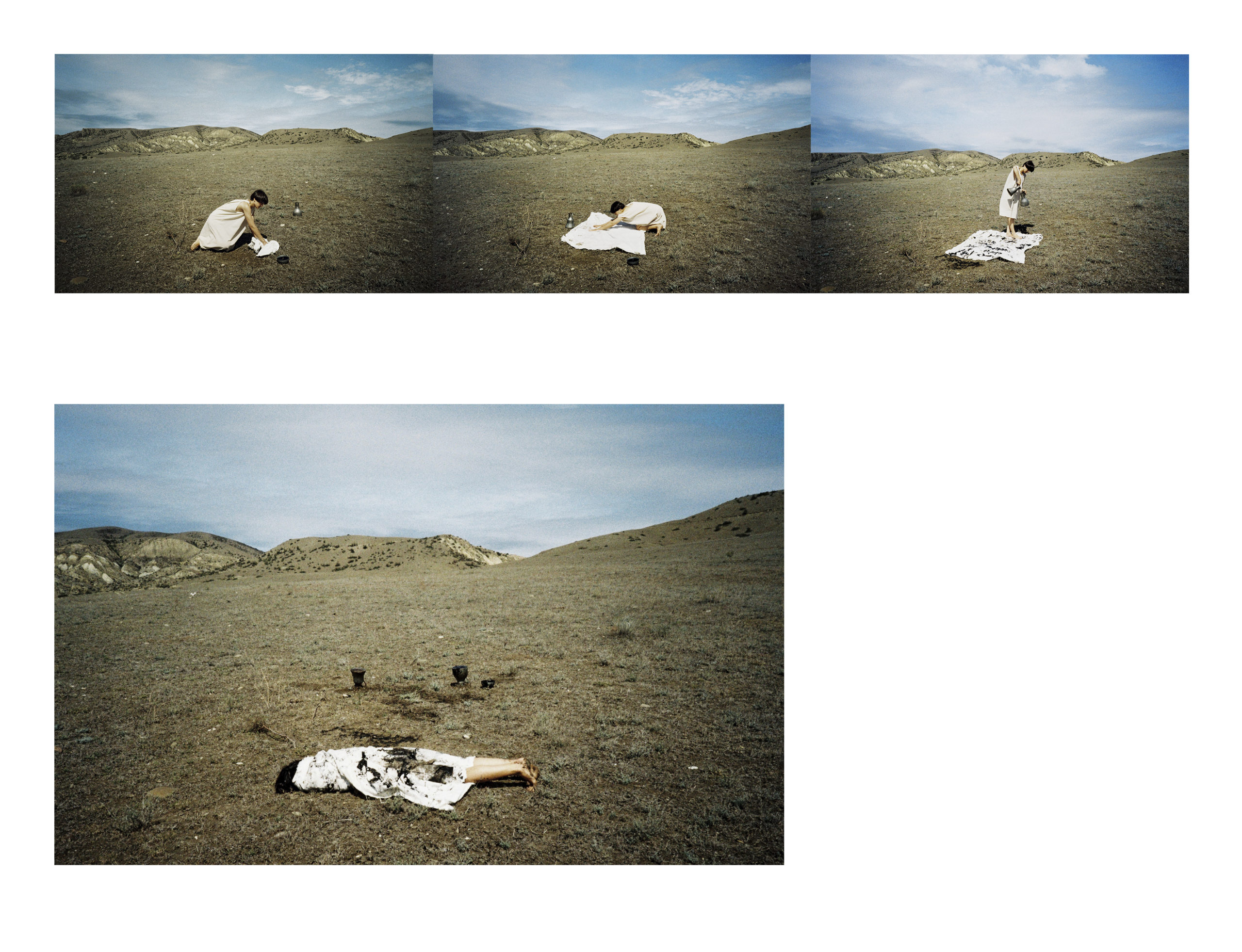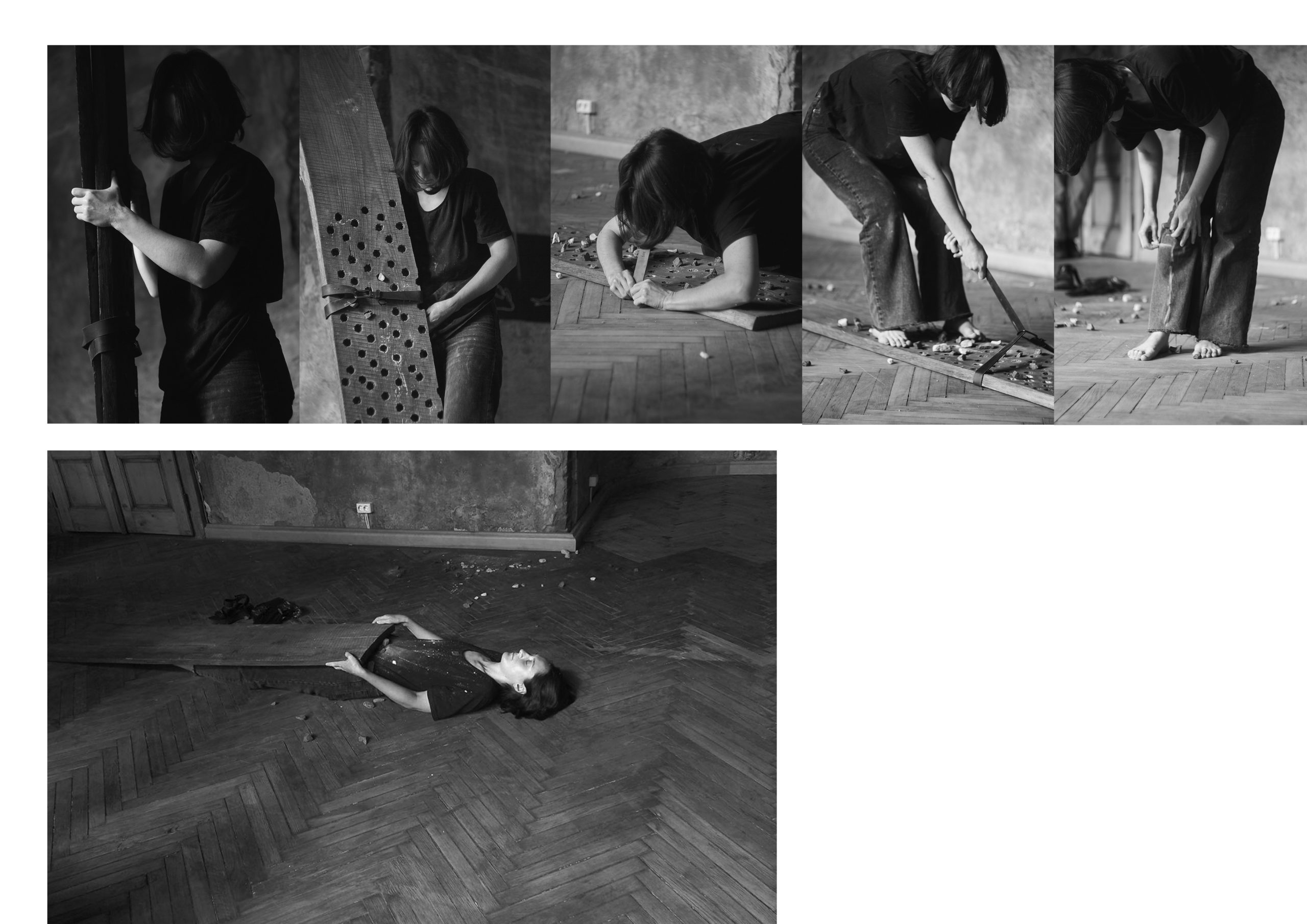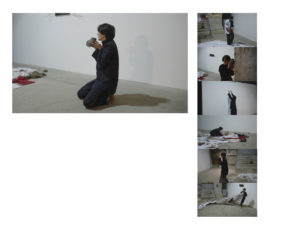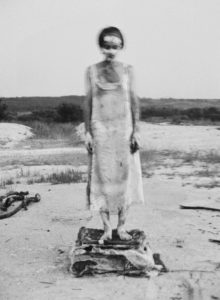Eliza Mamardashvili
an interdisciplinary artist who works in various mediums including performance, installation, and painting.
Elisa (born 1987, Zaporizhia, Ukraine) studied painting at the Kharkiv State Academy of Design. She now works in a variety of mediums including performance art, installation, painting, and vernacular photography. She is interested in the malleability of memories,
particularly as they intersect with national identity and conflict. She is inspired, in many ways, by her own identity and experiences as a Georgian.
Eliza lives and works in Kharkiv.
Works
“Everything came to be as it is”
Performance, 2021
Near the edge of Shida Kartli, Georgia
18 minutes 18 seconds

Two meters of white cloth, two metal jugs, bowl, black gouache, stone.
Mamardashvili took her first trip to Georgia in 2021. She describes this trip as an “initiation,” and the beginning of a new kind of artistic research method. Before the trip, her father drew her a map, making notes of which relatives she might visit and which rituals she must
perform. At the end of her two-week journey, Mamardashvili arrived in the region of Shida Kartli near the Mtkvara River (which can be translated to mean ‘Good water’). The landscape was quite different from the classic Georgian green mountains; the steppe mountains in the region were brown and dry.
In Shida Karli, Mamardashvili created “Everything came to be as it is,” a performance art piece inspired by the dry Georgian landscape and the relatives she had met during her travels. In the performance piece, Eliza memorizes the names of her relatives. Names that she had heard and seen, that her father had written on the map she carried with her.
She uses a white cloth to map her field of memories and metal water jugs as objects that simply bear witness to the existence of and mixing between two cultures: Georgia and Ukraine.
“Lots of broken bones”
Performance, 2021
CCA ErmilovCenter, Kharkiv, Ukraine
1 hour 17 minutes
Сlay objects, wood, ash, nails, metal needles, cloth, water.
Merge.
The multi-layered water flowing from one stream to another.
Flow.
Bed.
One connects with another, remembers or forgets.
The water betrays its presence.
Traces of people remain on every piece of fabric.
The long, snow-white acting as a river, or, a shirt, a dress, a pillowcase.
It’s important to hold onto them.
To connect.
Fabric-bones drawing strength from their spine.
Fragile.
Close and yet very far.
Scattered.
The shadows coalesce into a single chaos.
The sound is breaking.
Emptiness.
Fullness.
Manifestation through interaction.
Sound. Smell. Movement. Color. The form.
“Remains”
Performance, 2021
Land Art Symposium Mogritsa. Sumy, Ukraine.
The performance is divided across two days. 30 minutes the first day, 55 minutes the second
day.
Clay, gauze, charcoal, chalk, ash
The first day (image 1)
This is a reflection of what remains, how it is fixed in the space of action.
Turning to the image of the book,
which, in essence, opens and closes what is newly hidden inside of it.
The artist looks at herself through what is left on its pages.
Clay sheets with gauze are unused and, yet, they are going through changes.
From washing to writing letters,
from punching and breaking to gentle touch.
Eliza stands: limited, framed, described.
The formless sounds, quiet, turned into a roar, became an artifact.
The witness’ dress connects the days together.
The sheets are stacked, pressed by the feet.
Second day (image 2)
During the day, the artist braided bracelets from grass found deep in the forest,
tying them to the wrists of her friends.
In the evening she went back to the forest alone
where she unwove her dress into string and made bracelets for the wrists of the trees,
each different in character and shape, like people.
The dress was a remnant of the first day.
“Remove unnecessary”
Performance, 2022
Diogenes Gallery, Lviv, Ukraine
After evacuation, March 1, from Kharkov
Upon arrival in Lviv
I had to remove this fear from myself, these hellish sounds
Explosions in my city, my land, my home
Clean up and refresh; remove the redundant, accept the pain.
The instrument symbolizing purification in this performance is the Georgian threshing tool,
kevri, which has been used historically in both Georgia and Ukraine to clean wheat with
stones.
While I was collecting water-soaked stones in the rain, they absorbed the sound
between my feet and the ground.
This is memory.
Carved in stone, occupying space, written into songs you sing about yourself.
You are the one who holds the torn pieces on her lap, hiding wounds in your pocket.
This is serenity and rest, near the noise and chaos.
Yet, still the stones are raining.




